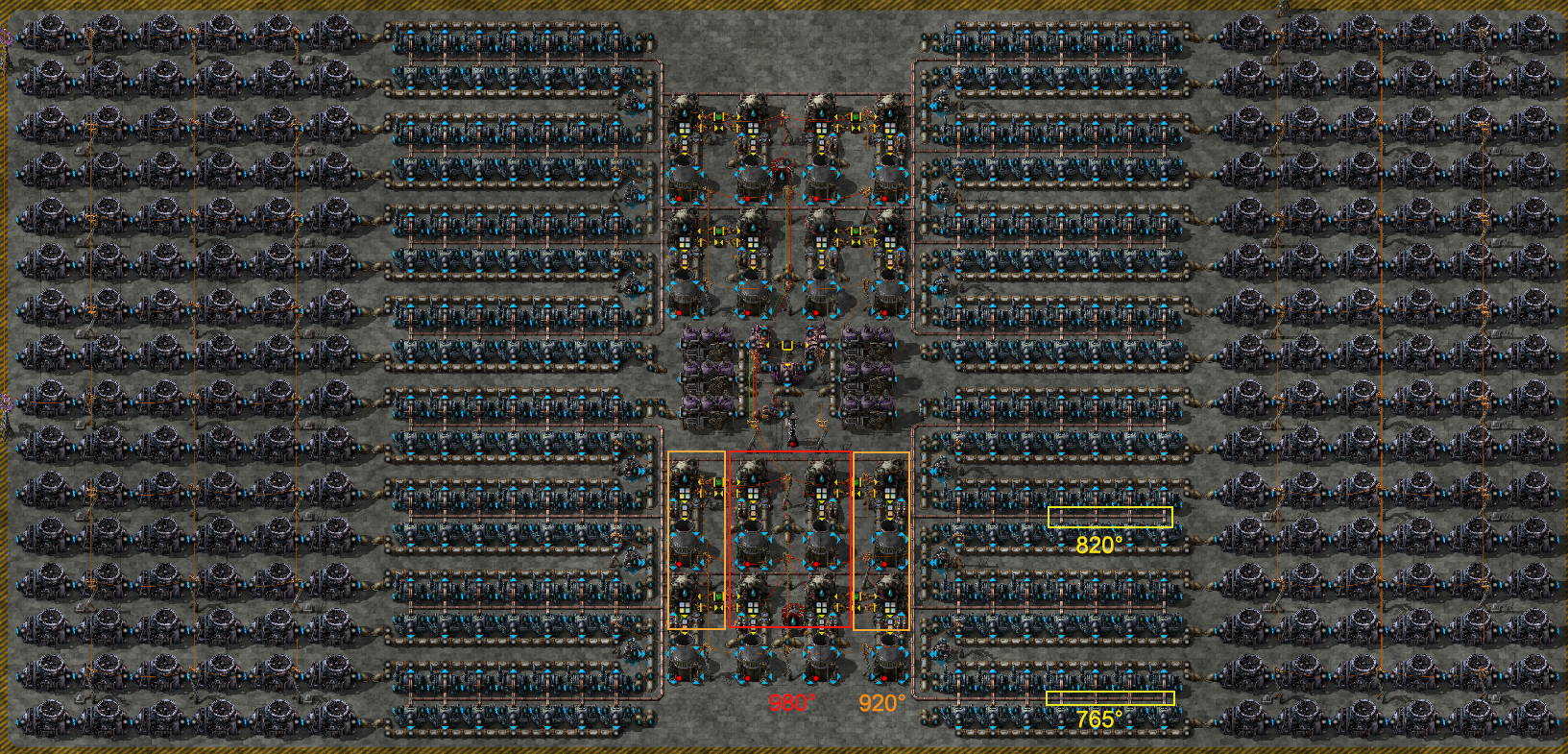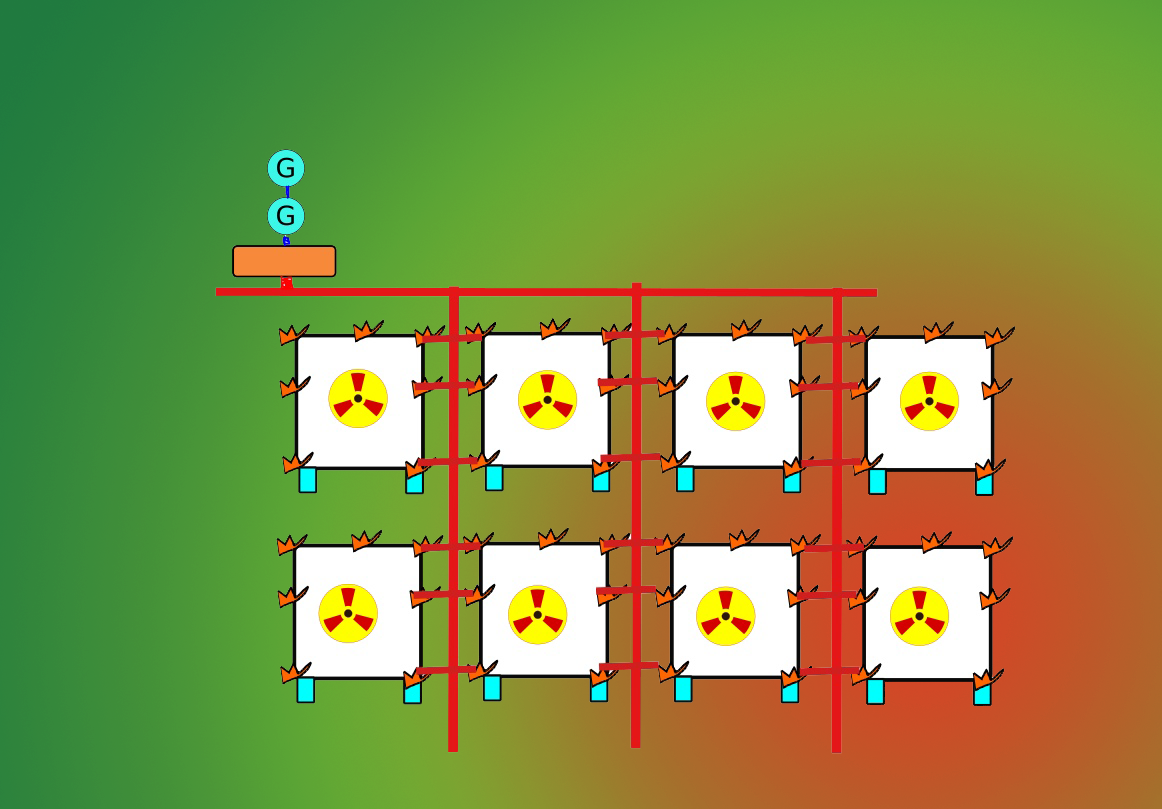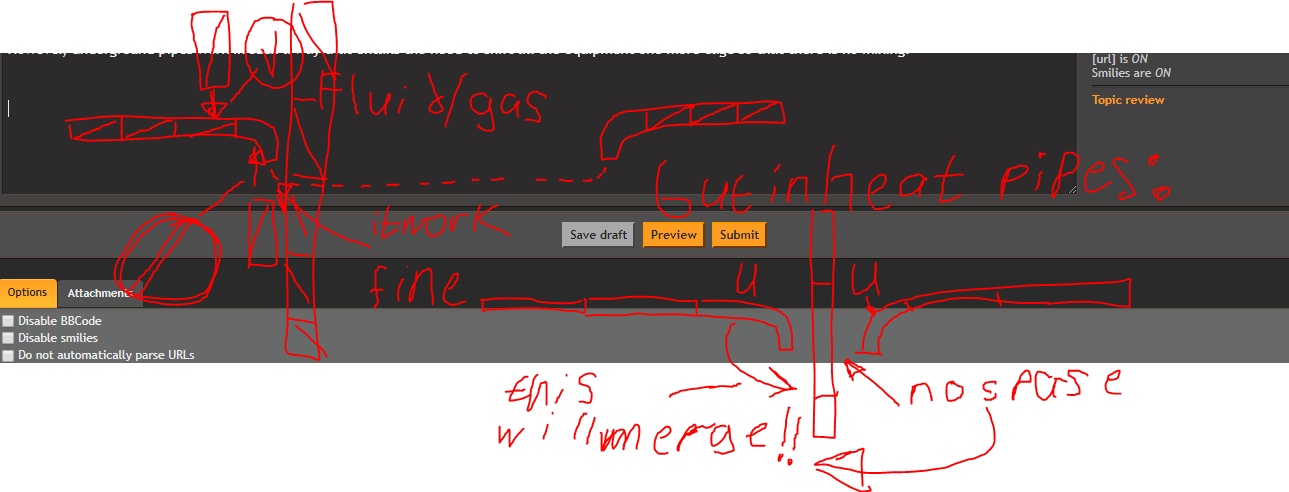Sorda wrote: Wed Aug 07, 2019 1:45 am
Hey. It seems that I don’t understand something at all.
What is the default reactor power for this mod? I do not rise above 23, and the temperature never rises above 480 degrees with turbines connected.
If you turn off the heat pipes, then in about five minutes the temperature rises to 1000 degrees, but when you connect the pipes, heat exchangers and turbines, the temperature drops quickly, and the power again does not rise above 23 megawatts.
You are misinterpreting the results you are getting. If you look at the diagrams in the first post here, you can see that depending on how warm your reactor is, you get different efficiency and power outputs.
Here is the link to the diagram -
https://i.imgur.com/J5dyOGr.png, alternativly there are tables in .ods format in the mods archive.
Now what that means in practice -
I assume that you play with the dewfault formulas by ownly, so I will explain it based on them. I myself enjoy Ingos formulas more.
To simplify the explanation, I will do it based on 1 single reactor with no bonusses based on ownly formula.
The two values, that interest us, are temperature and power output.
We see that below 500 degrees the reacctor outputs about 23 MW, and runs at 75% efficiency. That means, that a fuel cell in that temperature segment will have a fuel value about of 8GJ * 0,75 = 6GJ, and will last for about 6GJ/23MW = 260 seconds.
All that heat is dumped into the temperature of the reactor, and it starts to rise. At the same time, all your heat pipes and heat exchangers connected to the reactor take it away, to heat themselves up to the same temperature as your reactor. In factorio, heat capacity equals to 1MJ/C in heat pipes and to 10MJ/C (10000000J/C) in reactors.
Now for simplicitys sake lets ignore the heat exchangers and pipes, and focus on the reactor. 23MW output means that you get 23000000 Joules per second, meaning that a running disconnected reactor will heat it up by 23000000/10000000= 2,3 C per second.
Now what happens then is a funny thing. Since you have your heat exchangers connected to the reactor, and a way for the steam to be consumed, as soon as the reactor gets to 500C they turn on (this is a vanilla mechanic obviously).
And what happens then, they start to consume the energy stored in way of temperature of the reactor. The question is, how much do they consume?
The answer is, as it is stated in the tooltip, 10MW. But at this very moment our reactor is outputting only 23MW. This means, that as soon as you have over 2 heat exchangers, they start to actually cool down the reactor, since they each consume 10MJ/s, and our reactor is only outputting 23MJ/s, which means, that the temperature starts dropping.
For example's sake lets say we have 3 heat exchangers. That would mean, we have a consumption of 30MW, or 30MJ/s. Our reactor is outputting 23MW, or 23 MJ/s. That means, our delta is -7MJ/s, which then translates to -0.7 C/s in reactor temperature. That in return means, that instead of heating up more, your reactor cools down instead!
Since heat exchangers do not run under 500C, as soon as the temperature in your system (in pipes, exchangers, and ther reactor itself) drops to 500, the consumption ceases, and the reactor starts warming up again. Now since pipes are realtively slow in transmitting heat, the longer the pipe, the longer it takes for the heating-cooling cycles to commence.
Now that you understand how it all works, the question is what to do about it. The answer is - manage heat consumption according to reactor power output and temperature! This can be done by either cutting off the water inlet, or by cutting off steam output. Since the heat exchanger gets disabled by either of those, it means, that it does not in fact consume heat at all!
As a direct result of that, all the power and heat that reactors produces, does not get consumed, and instead heats up the reactor. And then, if we look at the diagram, funny stuff starts happening - the hotter your reactor is, the higher is the output, and the higher the efficiency.
As soon as you reach 500C, your output is at 29MW, and efficiency is at 76%. That means, that the cell now has a fuel value of about 8GJ*0,76=6,08GJ and will last for about 6,08GJ/29MW = 209 seconds.
The reactor is heating by 29J/s = 2,9C/s.
Reaching the temperature of 510C, your output is at 30MW, efficiency at 78%. Your fuel cells are now worth 8GJ*0,78=6,24GJ, and last for 6,24GJ/30MW = 208 seconds.
The reactor is heating precisely by 3C/s.
If we go back to our 3 heat exchangers that we had, and enable them, they would consume exactly 30MW; That means, that we consume all the heat reactor is producing, and the reactor temperature stays unchanged. We can now run the reactor at stable 510C outputting 30MW at miserable 0,78 fuel efficiency.
But since we are not stupid, we will not be doing that. Instead, we will let the reactor heat up further.
Reaching 900C, the reactor is outputting whopping 74MW, efficiency is at 142%! That means, the fuel cell is now worth not 8GJ anymore, but is instead worth 8GJ*1,42 = 11,36GJ! We are actually making free energy from nothing now. The cell now lasts for 11,36GJ/74MW for 153s.
We do have a small problem now though. Running with 7 heat exchangers means, we use only 70MW, running with 8 means we consume 80MW. That would mean that either the reactor is still heating up in the first case, or is cooling down in the second. Running at fixed 900C is not possible anymore, since we have to juggle our heat echangers, always running 7, and shortly turning on the 8th as soon as we start reaching 80MW output, to be able to drop temperature.
We could wait even more though, to get even more power and efficiency!
At 945 to 950C the reactor outputs exactly 80MW at 149% efficiency. Try calculating the fuel cell value and how long it will last yourself, to see if you have grasped how it works by now. Running precisely 8 heat exchangers would allow us to consume all the heat generated and keep the reactor stable.
Sounds pretty good, right? Start the reactor, disable heat exchangers, let it heat to 945, enable heat exchangers, boom, you got yourself a stable 80MW single reactor.
Not so fast.
Our theoretical model ignores a couple of things. First, we have "temperature inertia". Our pipes do not transmit heat instantly, which means, until the whole 80MW of heat consumption "travel" to the reactor, it actually could already have heated up to much higher temperatures, since 80MW of power production at this point mean that we are heating the reactor by 8C/s! It means it would take ONLY A SECOND for the reactor to get from 945C to 953C! Depending on your heat pipe layout, this may be nowhere enough time for the exchanger consumption to reach the reactor. That means, to be absolutely, positively sure that the reactor will stay at the stable temperature it might be actually more sensible to turn the exchangers on gradually, even before reaching 945C, to not let it heat up so fast, beginning with the ones furthest to the reactor, so that the las ones start consuming throug as little heat pipe as possible, to get the desired temperature control as quickly as possible. It also might make sense to have 9 heat exchangers, to be able to "catch" our reactor, if it manages to get to over 80MW, to cool it down again.
The second problem is, well, factorio's electrical system. Can you guarantee that your factory actually consume all the 80MW? If it does not, steam gets stockpiled, until the inventory of the exchanger and the turbines are full, and then the exchanger actually stops heating, and in turn, stops consuming heat, in turn meaning, your reactor unexpectedly starting to heat itself to the point of meltdown. It might be sensible to implement steam buffering, and turn the reactor on, only if you have space left for steam buffers to store the energy of at least one fuel cell. Don't forget, that due to efficiency, it may have a fuel value of over 8GJ, as shown before. Alternatively, or just to be save you can build the ECCS, to cool your reactor down, should the necessity arise.
Also, heating up the reactor means, that all the heat you produce in that time is in fact "wasted", since when stopped, the reactor will cool back down again, so it might be sensible to run a reactor only if you can burn through a reasonable amount of fuel cells, before turning it back on again.
This is as short an explanation of how to use the reactor, as it gets. Additional factors as neighbouring reactors, transmitting energy through accumulators, mox power plants, are still yours to discover. Maybe I will run a video on that later.
Also, @ownly and @ingo you are more than welcome to put my explanation in the first post, for better understanding of the mechanics.


